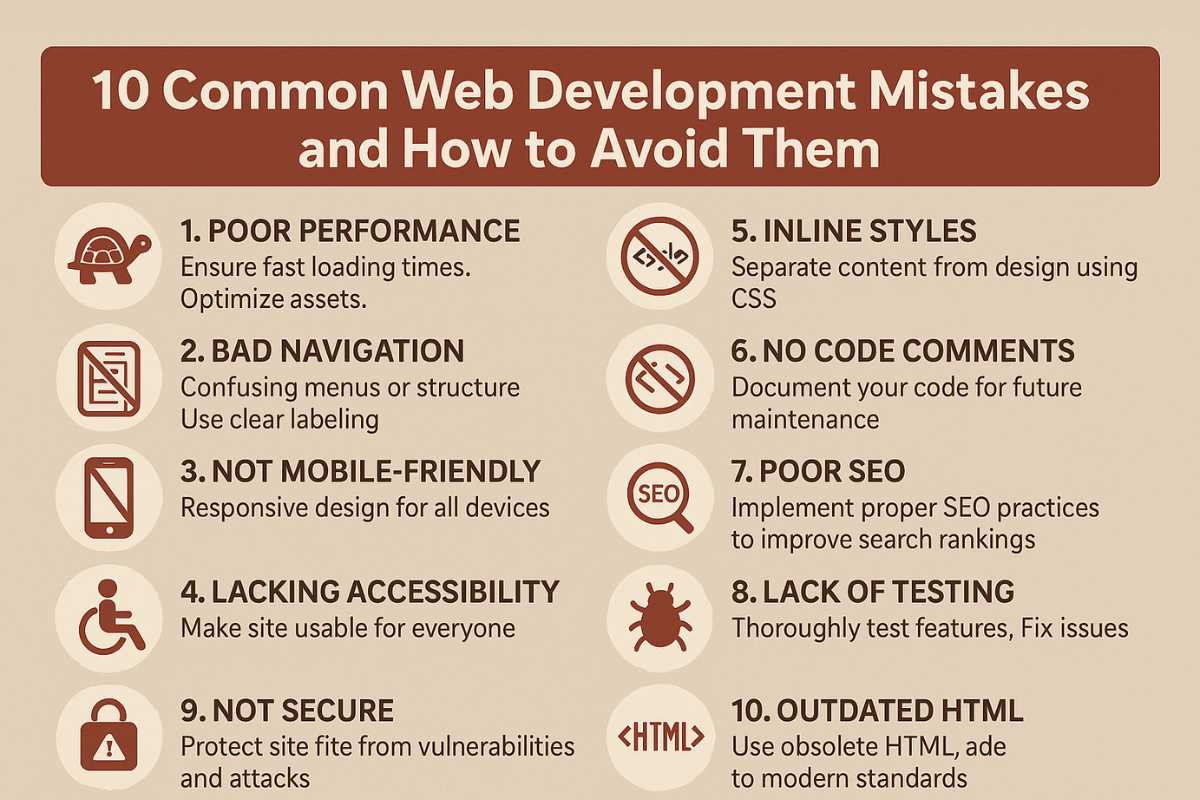Web development is an ever-evolving field, and while creating a website might seem straightforward, there are many pitfalls that developers—especially beginners—can fall into. Avoiding these common mistakes is essential to building functional, efficient, and user-friendly websites. In this article, we will explore the 10 most frequent web development mistakes and provide actionable solutions to prevent them.
1. Ignoring Mobile Responsiveness
With over 60% of internet users accessing websites via mobile devices, mobile responsiveness is no longer optional. A website that doesn’t adapt to various screen sizes can frustrate users and increase bounce rates.
How to Avoid:
- Use responsive frameworks like Bootstrap or Foundation.
- Test your website on multiple devices and screen sizes regularly.
- Avoid fixed-width layouts; use flexible grids and media queries.
2. Overlooking Website Performance (Table Representation)
Slow-loading websites are a major deterrent for visitors. Many developers focus on design and functionality while neglecting speed, which directly affects user experience and SEO rankings. The following table summarizes common performance-related mistakes and their solutions:
| Common Mistake | Impact | How to Avoid |
|---|---|---|
| Large Image Files | Slow loading time | Compress images using tools like TinyPNG or ImageOptim |
| Excessive HTTP Requests | Website lag | Minimize scripts, combine CSS/JS files |
| Poor Hosting Choice | Downtime & speed issues | Choose a reliable hosting provider with good uptime |
| Unoptimized Code | Slower page rendering | Clean, minify, and remove unused code |
| Ignoring Browser Caching | Repeat visits are slow | Implement caching mechanisms (e.g., browser or server caching) |
| Too Many Plugins | Conflicts and delays | Use only necessary plugins and keep them updated |
By keeping performance optimization in mind, you can significantly improve your website speed and overall user experience.
3. Poor SEO Practices
Even the most visually appealing website can fail if users cannot find it on search engines. Poor SEO practices, such as missing meta tags, slow loading, and unoptimized content, can prevent your website from ranking well.
How to Avoid:
- Use SEO-friendly URLs and meta descriptions.
- Optimize images with proper alt tags.
- Implement structured data for better search visibility.
- Focus on quality, keyword-rich content rather than keyword stuffing.
4. Not Prioritizing User Experience (UX)
A visually stunning website is meaningless if users find it confusing or difficult to navigate. Poor UX design leads to higher bounce rates and reduced conversions.
How to Avoid:
- Create intuitive navigation menus.
- Ensure consistent design across all pages.
- Use clear call-to-action buttons.
- Conduct usability testing to understand user behavior.
5. Neglecting Security Measures
Cybersecurity threats are a serious concern for web developers. Websites that lack proper security measures are vulnerable to attacks, potentially compromising user data.
How to Avoid:
- Use SSL certificates to enable HTTPS.
- Regularly update CMS platforms, plugins, and frameworks.
- Implement firewalls and anti-malware tools.
- Use strong passwords and two-factor authentication for admin accounts.
6. Using Outdated Technologies
Web development is fast-paced, and using outdated tools, libraries, or frameworks can hinder performance and security. Websites built on deprecated technologies may face compatibility issues with modern browsers.
How to Avoid:
- Stay updated with the latest versions of frameworks like React, Angular, or Vue.js.
- Avoid using deprecated HTML tags or CSS properties.
- Continuously learn and adopt new web standards and best practices.
7. Overcomplicating the Design
Many developers fall into the trap of creating complex, flashy websites, which can overwhelm users. Overcomplicated designs often slow down websites and make navigation confusing.
How to Avoid:
- Follow the principle of simplicity and clarity.
- Focus on clean layouts, readable fonts, and a consistent color scheme.
- Limit the use of animations and large media files.
- Prioritize content hierarchy for easy navigation.
8. Ignoring Cross-Browser Compatibility
A website may work perfectly on one browser but break on another if cross-browser compatibility isn’t considered. Ignoring this can alienate a significant portion of your audience.
How to Avoid:
- Test your website on major browsers: Chrome, Firefox, Safari, Edge.
- Use CSS resets or normalize.css for consistent styling.
- Avoid browser-specific code or provide fallbacks.
- Use tools like BrowserStack to test websites on multiple browsers and devices.
9. Poor Database Management
For dynamic websites, databases play a critical role. Poor database design or management can lead to slow queries, data loss, or security vulnerabilities.
How to Avoid:
- Normalize your database to reduce redundancy.
- Use indexed columns for faster queries.
- Regularly back up your database.
- Sanitize user inputs to prevent SQL injection attacks.
10. Failing to Test Before Launch
Launching a website without thorough testing can lead to broken links, unresponsive elements, and functionality issues. Skipping testing is one of the most common mistakes that can cost time and money later.
How to Avoid:
- Conduct unit testing, integration testing, and user acceptance testing (UAT).
- Test for responsive design, performance, and security.
- Use automated testing tools like Selenium or Cypress.
- Fix issues before the website goes live to ensure a seamless user experience.
Conclusion
Avoiding these common web development mistakes is crucial for building a successful website that is fast, secure, user-friendly, and optimized for search engines. By focusing on mobile responsiveness, performance, security, and user experience, developers can create websites that not only look good but also perform efficiently. Regular updates, testing, and learning new technologies will further ensure your site remains modern and effective.


